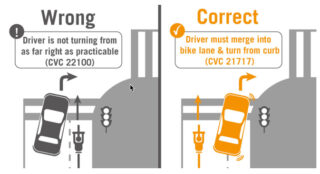
The San Francisco Bicycle Coalition is so afraid of how Uber’s autonomous vehicles take right turns at intersections that they’ve posted a warning for bike riders and have started a petition to force the company to end the practice.
Interestingly, the dangerous maneuver being made by Uber-bots is exactly what Oregon law requires — and what Portland’s chief bike planner prefers.
Here’s the deal:
The Bicycle Coalition’s position is that the cars are “not yet ready for our streets.” The main reason? When the cars come to an intersection they don’t merge into the bicycle lane prior to making a right turn at the intersection. Instead, they start their right turn at the intersection. Here’s more from their petition page:
“… the autonomous vehicle in ‘self-driving’ mode as well as the one in front of it took an unsafe right-hook-style turn through a bike lane. Twice. This kind of turn is … known to be one of the primary causes of collisions between cars and people who bike resulting in serious injury or fatality. It’s also an unsafe practice that we address in all of the safety curriculum we offer to professional drivers, including the videos we consulted on for Uber as recently as this fall… If you support safe streets, please sign the petition to tell Uber to address this dangerous and illegal turning behavior immediately.”
In Portland that same “dangerous and illegal” behavior is actually required by law.
Advertisement
Unlike California, our state maintains the idea that encouraging people in cars to merge across a bike lane prior to right turn is a bad idea.
This issue came to a head in 2007 after two high-profile right-hook collisions just two weeks apart resulted in the deaths of two bicycle riders. Following those tragedies some pointed to California’s law as a better alternative that would save lives. The Portland Bureau of Transportation disagreed.
Here’s PBOT Bicycle Coordinator Roger Geller in 2007 defending the practice:
“This [the California way] is an approach based on a ‘vehicular cycling’ model, which suggests that bicycles, as vehicles operating on the roadway, should behave the same as the primary vehicles for which the roadways were designed: automobiles. The benefit of this approach is that it takes cyclists who are going straight through an intersection away from the path of a right-turning motorist. It conforms to standard automobile operating rules, in which a vehicle going straight is always to the left of a vehicle turning right.
We believe there are a few problems with this approach.
The main problem is that vehicular cycling is generally best used by those cyclists who are already the most fit and confident. While knowledge of vehicular cycling and the skills it encourages are beneficial to all cyclists, requiring such behavior at each intersection would not feel comfortable to the vast majority of Portlanders — the very people we are working to attract to bicycling… We believe that inviting motorists into bicycle lanes creates three conditions that will be uncomfortable to most cyclists.”
Geller then pointed to the Dutch example, where the practice is to maintain a separation between bicycle and automobile users.
But that was almost a decade ago and Portland (like many other cities) still struggles with how to minimize the risk of right-hooks. And there are some signs that Portland is moving toward a different approach. Two years ago PBOT removed a bike lane at the intersection of N Rosa Parks Way and Albina and replaced it with a shared lane where bicycle and auto users are supposed to mix.
Carl Snyder, the PBOT engineer who oversaw the project, said the benefit of the shared design is that it makes it more clear where the conflict point exists. As to whether it makes cycling safer, he said, “The jury’s out.”
— Jonathan Maus, (503) 706-8804 – jonathan@bikeportland.org
BikePortland is supported by the community (that means you!). Please become a subscriber or make a donation today.

